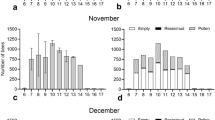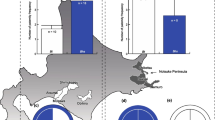Abstract
Comparisons of fore wings from 27 separate populations of 13 species ofAphelinus, Mesidia, andMesidiopsis revealed that the portion of the wing posterior to the major veins is divided into 8 setal regions (the subcostal cell constitutes a 9th). Each species has a characteristic number and/or placement of setae within each region. In some species the interpopulation variability is quite small, butEphelinus asychis Walker shows large variations associated with the species of host aphid attacted; individuals reared fromTherioaphis trijolii (Monell) are hairier in several regions than those reared fromMyzus persicae (Sulzer). A nomenclature for setae in the various wing regions is proposed.
Résumé
La comparaison des ailes antérieures de 27 populations particulières de 13 espèces d'Aphelinus, deMesidia et deMesidiopsis a révélé que la partie de l'aile postérieure aux nervures principales est divisée en 8 régions sétifères (la cellule sous-costale constituant une 9e région).
Chaque espèce possède un nombre et/ou un emplacement de séta caractéristique à l'intérieur de chaque région. La variation entre populations est assez faible pour quelques espèces, mais pourAphelinus asychis Walker, de grandes variations sont associées à l'espèce de puceron-hôte attaquée; les individus élevés à partir deTherioaphis trifolii (Monell) sont plus riches en séta dans certaines régions que ceux élevés à partir deMyzus persicae (Sulzer). Une nomenclature des séta pour les différentes régions de l'aile est proposée dans cet article.
Similar content being viewed by others
References
Bosch, R. van den, Schlinger, E. I., Dietrick, E. J., Hagen, K. S. &Holloway, J. K. — 1959. The colonization and establishment of imported parasites of the spotted alfalfa aphid in California. —J. Econ. Entomol., 52, 136–141.
DeBach, P. — 1964. Successes, trends, and future possibilities. In: Biological Control of Insect Pests and Weeds. (P. DeBach ed.). —Chapman & Hall, Lond., 673–713.
Férrière, C. — 1962. Aphelinides (Hym.) parasites de pucerons: les genresMesidia Förster etMesidiopsis Novicky. —Mitteil. Schweiz. Entomol. Ges., 35, 139–145.
— — 1965. HymenopteraAphelinidae d'Europe et du Bassin Méditerranéen. In: Faune de l'Europe et du Bassin Méditerranéen, Vol. 1, Masson & Cie, Paris.
Flanders, S. E. &Fischer, T. W. — 1959. The economic effect of aphidophagous insects on citrus in South China. —J. Econ. Entomol., 52, 536–537.
Gordh, G. &DeBach, P. — 1978. Courtship behavior in theAphytis lingnanensis group, its potential usefulness in taxonomy, and a review of sexual behavior in the parasitic Hymenoptera [Chalcidoidea: Aphelinidae]. —Hilgardia, 46, 37–75.
Graham, M. W. R. de v. — 1969. ThePteromalidae of Northwestern Europe [Hymenoptera: Chalcidoidea]. —Bull. Br. Mus. (Natur. Hist.) Entomol., suppl. 16.
Hagen, K. S. &van den Bosch, R. — 1968. Impact of pathogens, parasites and predators on aphids. —Annu. Rev. Entomol., 13, 325–384.
Haldeman, S. S. — 1851. —Penn. Farm. J., 1, Entomol. No 4, 129–131.
Jackson, H. B., Rogers, C. E. &Eikenbary, R. D. — 1971. Colonization and release ofAphelinus asychis, an imported parasite of the greenbug. —J. Econ. Entomol., 64, 1435–1438.
Jasnosh, V. A. — 1963. New species of the genusAphelinus Dalm. [Hymenoptera: Chalcidoidea] in the Fauna of the U.S.S.R. —Entomol. Obrez., 42, 178–185.
Mackauer, M. — 1972. Aphid-attacking genera ofAphelinidae [Hymenoptera], including the description of a new genus. —Can. Entomol., 104, 1771–1779.
Mercet, R. G. — 1921. Fauna Ibérica. Himenópteros Fam. Encírtidos. —Mus. Nac. Cienc. Natur., Madrid.
Miller, C. D. — 1970. The Nearctic species ofPnigalio andSympiesis [Hymenoptera: Eulophidae]. —Mem. Entomol. Soc. Can., No 68.
Nikol'skaja, M. N. &Jasnosh, V. A. — 1966. TheAphelinidae of European part of the U.S.S.R. and the Caucasus. —Izdatel'stvo Akad. Nauk S.S.S.R., Moskva-Leningrad, 295 pp. (In Russian).
Peck, O. — 1963. A catalogue of the NearcticChalcidoidea [Insecta: Hymenoptera]. —Can. Entomol, Suppl. 30.
Richards, O. W. — 1956. Hymenoptera. Introduction and keys to families.Handbook Ident. Br. Insects, 6, pt. I.Lond. R. Entomol. Soc.
Rosen, D. — 1966. Keys for the identification of the hymenopterous parasites of scale insects, aphids, and aleyrodids on citrus in Israel. In: Studies in Agricultural Entomology and Plant Pathology. —Jerusalem (Hebrew Univ.): Manges Press, Scripta Hierosolymitana, 18, 43–79.
Simpson, G., Roe, G. A. &Lewontin, R. C. — 1960. Quantitative Zoology. —Harcourt, Brace & World, New York, 440 pp.
Timberlake, P. H. — 1924. Records of the introduced and immigrant chalcidflies of the Hawaiian Islands [Hymenoptera]. —Proc. Haw. Entomol. Soc., 5, 418–449.
Weis-Fogh, T. — 1973. Quick estimates of flight fitness in hovering animals, including novel mechanisms for lift production. —J. Exper. Biol., 59, 169–230.
Author information
Authors and Affiliations
Rights and permissions
About this article
Cite this article
Hennessey, R.D. Setal patterns of the wings ofAphelinus, Mesidia, andMesidiopsis [hym.: aphelinidae], their values as taxonomic characters. Entomophaga 26, 363–374 (1981). https://doi.org/10.1007/BF02374711
Issue Date:
DOI: https://doi.org/10.1007/BF02374711




